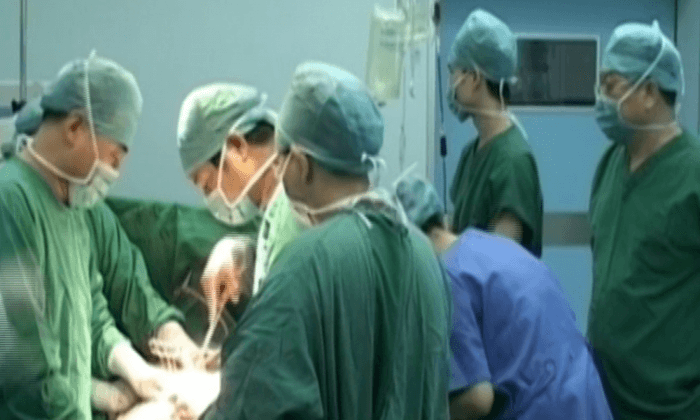A Chinese businessman from the mainland met with clients at a location in South America to discuss future orders. In the telephone interview, he voiced his concerns regarding China’s economy saying, “200 million Chinese, including both migrant and other workers, are unemployed.” He then disclosed that “Gross Domestic Product (GDP) growth was ‘just below 4 percent.’” All present were shocked.
There are reasons to believe this Chinese businessman’s numbers are not off the mark, even though they differ significantly from the regime’s official unemployment and growth rates.
Smoke and Mirrors
“When the central government mandates a certain growth rate, the locals [governments] jump,” said David Li, director of Tsinghua University’s Center for China in the World Economy, as quoted by Business Week. “That’s the easiest way to create growth.” The reports come back from the provincial cadre with the required production numbers.
In recent official announcements, migrant worker unemployment was 20 million. The CCP also reported a 4.2% unemployment rate on registered (urban) workers for the end of 2008, as reported by Xinhua News Agency on Jan. 21, 2009.
On Feb. 16, Xinhua News Agency reported that the January GDP growth rate was 6.8%.
Economists Are Saying
Economists are providing a different picture of China’s economic health than that given by the official statistics.
Professor Zeng Xiangyuan, Director of the Academy of Labor and Social Relations at the Renmin University of China, is quoted in the blog Seeking Alpha as saying that China’s unemployment rate for both urban and rural areas should be between 24 to 27 percent if converted to international standards.
This agrees with the Chinese businessman’s estimate of 200 million unemployed, which would amount to an unemployment rate of 25 percent (excluding Hong Kong and Macau).
In a dramatic statement, Albert Edwards of Societe Generale is quoted by the blog Seeking Alpha as saying, “We cannot highlight strongly enough how truly mind-boggling Japan’s collapse in exports to China is. Last July they were expanding at a 16 percent year over year pace. Now they are contracting at a 35 percent year over year rate! This is a phenomenon throughout the region.
“Hence, despite the notoriously manipulated Chinese GDP data showing a shocking slowdown in GDP growth to 6.8 percent year over year, I would eat my hat if the Chinese economy was doing anything other than contracting right now.”
According to Nouriel Roubini, an economics professor at New York University who has grown famous for accurately predicting the global financial crisis, China’s GDP growth this year will not exceed 5 percent (See: China’s Tough Employment Times)
China economist, Mark Williams, from London based Capital Economics, said in an interview with Voice of America that he also anticipated a growth of 5 percent this year in China’s GDP.
The Chinese businessman’s estimate of the growth rate at “just under 4 percent,” then, seems very plausible.
What Next?
The regime reported in 2008 that a GDP growth rate of 6 percent was considered a critical threshold required to absorb incoming young workers and maintain sufficient jobs for the workforce in general. A lower rate could bring about major social disruptions.
Zhang Ping, president of China’s National Commission for Development and Reform, said at a press conference on Nov. 27, 2008, “excessive bankruptcies and production cuts will lead to massive unemployment and stir social unrest” in 2009, as reported in China Daily on the same day.
With a true unemployment rate of 25 percent and a growth figure at or below 5 percent, the conditions for social instability have arrived in China.
In China, the regime’s media are blaming the United States’ failure to regulate its financial institutions as the cause of the Global Financial Crisis. Hu Jintao, head of the Chinese Communist Party (CCP), is meeting with leaders around the world who are disaffected from the United States, telling them the United States has failed them and China can help them.
Ms. He Qinglian, perhaps the best known commentator on China’s economy, reports “Newspapers in China have been publishing numerous series of articles that examine the problems in China’s real estate, stock market, and banks. These reports state that the root cause has been the U.S. financial crisis.”
Ms. He continues, “What’s most surprising is the CCP has been patting itself on the back. It boasts that the Chinese and Russian models supposedly prospered, while stating that the financial crisis in the United States is due to its impoverished free market system and that its well-established freedom and democracy have collapsed.” (See: Financial Crisis in the U.S. and China—Comparing Apples and Oranges)
Ms. He says that China’s economic woes are homegrown. Among other factors,she points out that “The continuing bankruptcies in China were also not affected by the U.S. financial crisis. Last year [2007], toys from China were strongly boycotted, because they contained high levels of lead. Many millions of toys had to be recalled. ... On March 13, 2008, the Shanghai stock exchange fell by 3,971 points. That day, 700 billion yuan were lost...this had little to do with the U.S. financial crisis. It is China’s problem,” (See:China: Not a Financial but an Economic Crisis)
With its economy in a nosedive and social unrest growing, the CCP may feel threatened. It is capable of acting brutally under such circumstances. This is apparent from the 1989 Tiananmen Student Massacre, as well as the almost ten-year-long persecution of Falun Gong adherents.






